 W
WAtlantogenata is a proposed clade of mammals containing the cohorts or superorders Xenarthra and Afrotheria. These groups originated and radiated in the South American and African continents, respectively, presumably in the Cretaceous. Together with Boreoeutheria, they make up Eutheria. The monophyly of this grouping was supported by some genetic evidence.
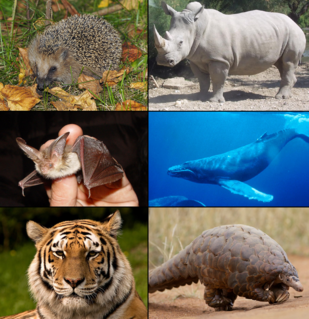 W
WBoreoeutheria is a clade (magnorder) of placental mammals which is composed of the sister taxa Laurasiatheria and Euarchontoglires (Supraprimates). It is now well supported by DNA sequence analyses, as well as data regarding retrotransposon presence or absence. Placental mammals outside of this clade are the clades Xenarthra and Afrotheria.
 W
WCarnivoramorpha are a clade of mammals that includes the modern order Carnivora.
 W
WEpitherians comprise all the placental mammals except the Xenarthra. They are primarily characterized by having a stirrup-shaped stapes in the middle ear, which allows for passage of a blood vessel. This is in contrast to the column-shaped stapes found in marsupials, monotremes, and xenarthrans. They are also characterized by having a shorter fibula relative to the tibia.
 W
WThe Eumuroida are a clade defined in 2004 by Steppan et al. that includes rats, mice and related species, though not all rodents; in other words, a specific group of muroid rodents. The clade is not defined in the standard taxonomic hierarchy, but it is between superfamily and family.
 W
WFerae is a clade of mammals, consisting of the orders Carnivora and Pholidota. An alternate name, Ostentoria, has also been proposed for a grouping of the Carnivora and Pholidota. The last common ancestor of extant Ferae is supposed to have diversified ca. 78.9 million years ago. Several extinct orders such as creodonts are members of Ferae as well.
 W
WHolotheria are a diverse group of mammals that are descendants of the last common ancestor of Kuehneotherium and Theria.
 W
WMeridiungulata is an extinct clade with the rank of cohort or superorder, containing the South American ungulates Pyrotheria, Astrapotheria, Notoungulata and Litopterna. It is not known if it is a natural group; it is known that both Litopterna and Notoungulata form a clade based on collagen evidence, but the placement of the other members is uncertain. it was erected to distinguish the ungulates of South America from other ungulates. Relationships between the orders inside Meridiungulata remain unresolved and it could well be a "wastebasket taxon". Most Meridiungulata died out following the invasion of South America by North American ungulates and predators during the Great American Interchange, but a few of the largest species of notoungulates and litopterns survived until the end-Pleistocene extinctions. The notoungulate Mixotoxodon was able to invade North America to as far as present-day Texas.
 W
WMetatheria is a mammalian clade that includes all mammals more closely related to marsupials than to placentals. First proposed by Thomas Henry Huxley in 1880, it is a slightly more inclusive group than the marsupials; it contains all marsupials as well as many extinct non-marsupial relatives.
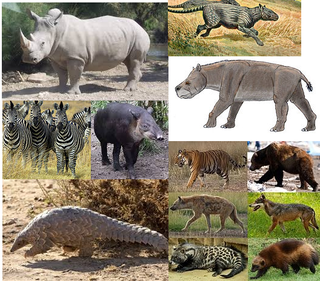 W
WPegasoferae is a proposed clade of mammals based on genomic research in molecular systematics by Nishihara, Hasegawa and Okada (2006).
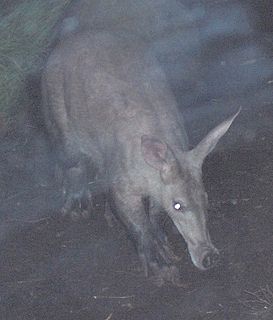 W
WPseudoungulata, or "false hoofed mammals", is a possible clade made up of two subgroups, aardvarks and paenungulates. Before this group was proposed, it was thought that aardvarks were more closely related to xenarthrans. However, all of these mammals are now considered to be part of Afrotheria, which also includes elephant shrews and afrosoricidans. Other positions of aardvarks within Afrotheria are possible, such as being closest relatives of elephant shrews and/or afrosoricidans.
 W
WSimplicidentata is a group of mammals that includes the rodents and their closest extinct relatives. The term has historically been used as an alternative to Rodentia, contrasting the rodents with their close relatives the lagomorphs. However, Simplicidentata is now defined as including all members of Glires that share a more recent common ancestor with living rodents than with living lagomorphs. Thus, Simplicidentata is a total group that is more inclusive than Rodentia, a crown group that includes all living rodents, their last common ancestor, and all its descendants. Under this definition, the loss of the second pair of upper incisors is a synapomorphic feature of Simplicidentata. The loss of the second upper premolar (P2) has also been considered as synapomorphic for Simplicidentata, but the primitive simplicidentate Sinomylus does have a P2.
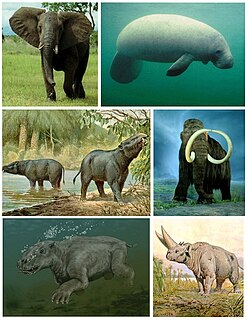 W
WTethytheria is a clade of mammals that includes the sirenians and proboscideans, as well as the extinct order Embrithopoda.
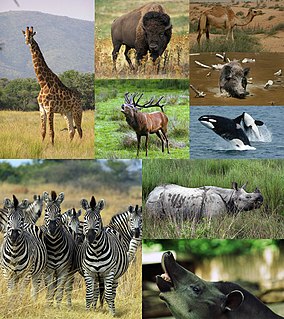 W
WUngulates are members of a diverse clade of primarily large mammals with hooves. These include odd-toed ungulates such as horses, rhinoceroses and tapirs, and even-toed ungulates such as cattle, pigs, giraffes, camels, sheep, deer, and hippopotamuses. Cetaceans are also even-toed ungulates, although they do not have hooves. Most terrestrial ungulates use the tips of their toes, usually hoofed, to sustain their whole body weight while moving.
 W
WZooamata is a proposal for a clade of mammals uniting the Ferae with the Perissodactyla. The name is constructed from Greek and Latin to mean "animal friends", a reference to the inclusion of cats, dogs, and horses.